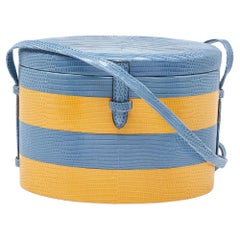Blue Lizard Trunk
2010s Colombian Shoulder Bags
Carolina Herrera for sale on 1stDibs
Born into a family of wealth and sophistication in Caracas, Venezuela, but without a trace of design education, Carolina Herrera launched her eponymous fashion empire in 1981. Modeling her aesthetic on the principles of refined, simple elegance, she has gone on to defy all expectations.
Style, that elusive je ne sais quoi, is often hard-won, acquired over years of experimentation and missteps. Precious few are born with it. Carolina Herrera may well be one of them. And if she wasn’t born with it, she was most assuredly born into it, raised by wealthy and refined women in the most rarefied of circumstances back in Venezuela. Her mother and her grandmother were both perfectly put together, had their own dressmakers — even a live-in seamstress. Everything within Herrera’s reach at home was of the utmost quality. Hers was a privileged life, and no one appreciates that fact more than she.
Herrera brought that aesthetic to her first collection of clothing and accessories in 1981, encouraged by éminence grise Diana Vreeland, then the editor in chief of Vogue. Herrera was initially interested in designing textiles (she worked in a publicity role for Emilio Pucci — the iconic clothing and housewares maker — during the 1960s). It was Vreeland who planted the fashion seed. When it took root, Herrera returned to Caracas, and with the help of Guy Mellier, her personal couturier, she came up with a collection she felt was New York–ready. She never studied fashion and didn’t know how to cut or sew. “What I understood was proportion, and I had a good eye.” She knew not only what looked good on her but also on other women, too.
Herrera unveiled her first collection at the Metropolitan Club on Fifth Avenue. The fashion press was hard on her; “they didn’t have faith,” is how she explains it today. But how about the women in the audience, did they like what they saw? Herrera leans in and says with a smile, “A lot!” The buyers liked the collection, too — enough to place orders. (And they’re still placing orders.)
She quickly became synonymous with sophistication for her glamorous evening dresses, which eventually earned accolades in magazines, prime real estate in Manhattan boutique windows and a heavyweight client roster that included Jacqueline Kennedy Onassis.
As her business has evolved — in 2010 it reached $1 billion in sales — so has Herrera herself. In the 1970s and before she became a designer, she used to dance until the wee hours at Studio 54, pal around with Calvin Klein, Bianca Jagger, Halston and Andy Warhol. Through all the madness — every bit of which she enjoyed — she remained unscathed. No scandals, no gossip, no whispers. She’s been famously photographed by Robert Mapplethorpe, Arthur Elgort, Norman Parkinson, David Seidner, Mario Testino, Bruce Weber and, yes, Ron Galella. (“I’ve never said no to the paparazzi,” she explains. “I smile, let them take the picture and move on.”)
Find a collection of vintage Carolina Herrera shoes, shirts, day dresses, handbags and more on 1stDibs.
Finding the Right shoulder-bags for You
Ever since we’ve needed an accessory to carry our personal items when we’re on the go, shoulder bags have proven indispensable. Today, vintage and designer shoulder bags are such a treasured part of fashion history that they even get their own museum exhibitions.
Prior to bags becoming an essential piece of any ensemble for any gender, women wore pockets strung on ribbons as garments that were separate from their gowns, accessible by openings in the fabric. Small handbags and handheld purses were developed before the accessory gained importance as functional and fashionable. Most had more in common with wallets than anything else.
While the bags of the 16th century warranted ornament, such as exteriors embroidered with silver-gilt thread and beads, it wasn’t until the late 18th century and early 19th century that the design and craft of bags had really broadened. Handheld purses were finished with details that were meant to garner attention, and bags were fitted with shoulder straps. A stylish shoulder bag meant that women could tote jewelry, cash and perhaps a decorative snuff box full of tobacco to an evening ball across town.
The early 1900s saw the introduction of gold and silver minaudières. The patenting of these compact bejeweled clutches has been attributed to revered French jewelry house Van Cleef & Arpels, and today they remain a fashion favorite. One of Judith Leiber’s innovative minaudières even earned a role in the movie Sex and the City.
A luxury shoulder bag is a work of art with a long, fascinating origin story, and entire brands and fashion lines have emerged around creating the perfect versions of shoulder bags and top-handle bags. For example, the iconic Hermès Kelly bag, which was popularized by actress Grace Kelly, is a widely coveted, collected and often faked entry from the handbag hall of fame. And while vintage Gucci tote bags have their own dedicated fan base, collectors and lovers of luxury are likely familiar with the Dionysus, a pared-down Gucci shoulder bag that manages to make a substantial statement anyway.
Embrace a classic look with a vintage shoulder bag designed by Chanel, Givenchy or Fendi — find yours on 1stDibs today.
